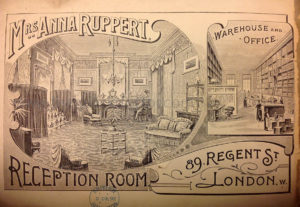For part 1 about Swaim’s Panacea, click here.

Within a few years of establishing his products, William Swaim was enjoying the benefits of endorsements from some of Philadelphia’s most eminent physicians, including Nathaniel Chapman, William Gibson, William Pott Dewees, Thomas Parke and James Mease – and he didn’t even have to make them up.
For the past ten years or so, sarsaparilla had been attracting renewed medical attention in the US as a blood purifier, so it was probably with this in mind that the doctors were well-disposed towards Swaim’s medicine. Swaim combined the sarsaparilla syrup with oil of wintergreen, giving it a pleasant taste that made it a hit with patients too. Gibson’s endorsement gives a further clue to its popularity:
I have always found it extremely efficacious, especially in secondary syphilis and mercurial disease. I have no hesitation in pronouncing it a medicine of inestimable value.
The symptoms of secondary syphilis, of course, disappear of their own accord before the disease goes into a latent phase – no wonder the Panacea and so many other treatments of the time claimed success.
In 1827 the New York Medical Society appointed a Committee on Quack Remedies, and the Philadelphia Medical Society soon did likewise. While the New York Committee acknowledged the possible benefits of the Panacea and other sarsaparilla-based syrups, the Philadelphia one was tougher, gathering numerous cases of people who had taken the medicine. The outcomes of these cases varied from no effect at all, to ‘a most violent and alarming bowel complaint’, to death. Analysis showed that the remedy contained corrosive sublimate (mercuric chloride).
Later, the New York Committee released its own analysis, done at the time of the investigation but not published, which showed that they too knew all along that it was mercury – so there, Philadelphia. A new analysis in 1831 also showed the presence of arsenic, but the ingredients varied from batch to batch and it was the luck of the draw whether you got the poisons.
By this time the doctors’ enthusiasm had waned. Chapman wrote:

Early in the history of that article, I was induced to employ it, as well from professional as common report in favour of its efficacy, and was well pleased at the result in several cases. But! more extensive experience with it soon convinced me that I had overrated its value, and for a long period I have entirely ceased to prescribe it.
Gibson admitted that: In several cases that came under my notice, ptyalism has followed the use of it. (Excessive salivation, a symptom of mercury poisoning.) Their testimonials, however, were now out of their control and there was nothing they could do to stop Swaim continuing to use their names.
In 1836, long after the US physicians had backtracked on their endorsement of the nostrum, British journal The Medical-Chirurgical Review condemned them in true Tunbridge Wells style:
We were utterly astonished to find an impudent PANACEA bolstered up with the names and certificates of some of the first authorities, in the medical profession, of the United States!…
We are mortified and grieved, beyond measure, to find professional propriety (to give it no other name) at so low an ebb among our brethren in America! This admonition from Europe will surely rouse the faculty of the United States to some sense of the duty they owe to their brethren throughout the world.
The early success of Swaim’s Panacea inspired imitators to cash in with their own versions, and they were completely blatant about it. ‘Swayne’s Panacea’ hoped to dupe punters who weren’t paying attention, and ‘Shinn’s Panacea’ was sold with the statement: The subscriber having discovered the composition of Swaim’s celebrated Panacea, has now a supply on hand for sale.
One of the heavyweight rivals was Parker’s Renovating Vegetable Panacea, the ads of which contained fighting talk:
In justice to myself, I have been induced to reply to a false and unjustifiable attack made upon me and others by Swaim, the vender of a certain Panacea in this city.
I have been acquainted with the ORIGINAL RECIPE FROM WHICH SWAIM MANUFACTURES HIS MEDICINE FOR UPWARD OF TEN YEARS. IT WAS OBTAINED FROM MY FATHER-IN-LAW, WHO NOW RESIDES IN THE STATE OF NEW YORK, WHO HAS USED IT FOR THIRTY YEARS , AND PERFORMED INNUMERABLE EXTRAORDINARY CURES WITH IT.
Parker used his own version of the Hydra image, which, in a nice dig at Swaim’s battling Hercules, shows the mythical beast already defeated:
Swaim’s reply tried to turn the copy-cat ads to his advantage:
This medicine had been used for seven years before an attempt was made to imitate it; but the great demand for it, and its wonderful success, have induced a great number of persons to imitate it in various ways—upwards of fifty different mixtures have been got up in imitation of it, which is a convincing proof of it being a medicine of great value.
Although the initial fame of the medicine declined, it continued to be made throughout the 19th and early 20th centuries, latterly with a different formula involving alcohol and a huge amount of sugar.





Fascinating article & great illustrations. These Panaceas seem comical in a way now but how many people did they kill, no wonder the doctors wanted their endorsments removed.
I have just discovered your blog — a wonderful and fascinating resource.
The advertisements are a welcome reminder that not much, other than the style of language, has changed in human nature over the centuries.
I very much enjoyed my visit to your site. as the last commentator but one said, not much has changed at all! Actually I find that comforting…
Thanks, Jane!